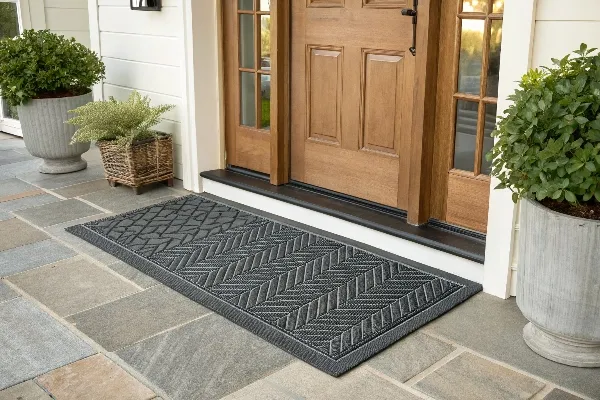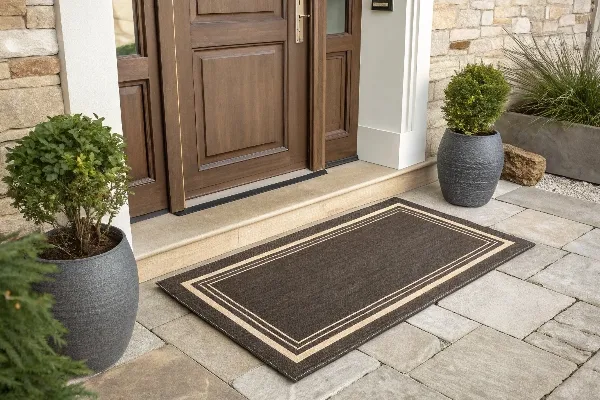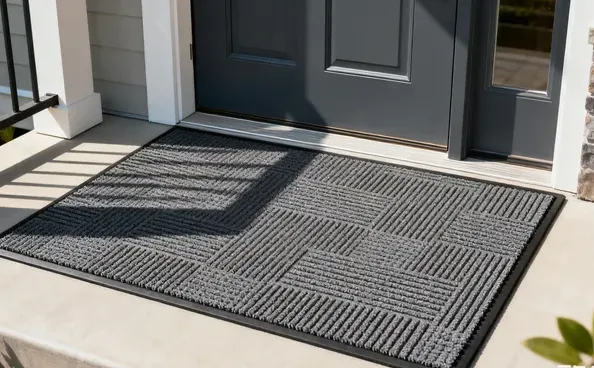I used to struggle with muddy footprints and worn-out mats at my doorstep. I knew I needed a better solution.
A good exterior door mat should be durable, weather-resistant, and sized correctly. It should scrape dirt effectively, absorb moisture, and stay firmly in place. Choosing the right material, size, and color improves both functionality and appearance.

When I found the perfect mat for my front door, it made a noticeable difference. Let’s break down how you can choose one that works for your home.
Should doormat be as wide as door?
I used to place small mats that barely covered the entrance. Dirt still got inside. I learned that size matters.
Yes, the doormat should match or slightly exceed the width of the door. This ensures better coverage, effectively catches dirt, and improves visual balance. A properly sized mat keeps your entrance cleaner and safer.

Why Door Mat Width Matters
I once had a narrow mat that only covered part of my front door. It looked undersized and did little to trap dirt. After some research, I discovered that the width of the mat plays a key role.
Coverage and Functionality
Ideally, the mat should be as wide as your door or slightly wider. Standard exterior doors are usually around 36 inches wide. A mat measuring 30-36 inches is appropriate for a single door. For double doors, mats can range from 60-72 inches. The wider the mat, the more surface area people can use to wipe their shoes.
A mat that covers the full width ensures that no one steps past it. Everyone entering wipes their feet effectively. This means less dirt, mud, or debris inside the house.
Visual Appeal
I noticed that a mat too small for the doorway looks out of proportion. A mat matching the door width1 complements the entrance. It creates symmetry and enhances curb appeal.
Practical Considerations
When choosing width, also consider surrounding space. If your doorway has sidelights or steps, measure those areas too. You want the mat to fit without overlapping awkwardly.
Here’s a simple size reference:
| Door Type | Recommended Mat Width |
|---|---|
| Single Door | 30-36 inches |
| Double Door | 60-72 inches |
| Door + Sidelights | Measure total width for fit |
Since I switched to a mat matching my door width, my entrance looks tidier, and I deal with less dirt indoors.
Which color doormat is good for the main door?
I used to pick mats based on color alone, but they often showed dirt fast. I realized color affects both style and maintenance.
Neutral or dark shades like brown, gray, or black work best for main doors. They hide dirt, match various home styles, and require less frequent cleaning. Brighter colors add personality but may show wear faster.

Balancing Color Choice and Practicality
Choosing the color of a doormat seems simple, but I’ve learned it’s more important than it appears. The color affects how clean the mat looks, how often you’ll need to clean it, and how well it blends with your home’s exterior.
Dark and Neutral Colors
Colors like brown, charcoal, dark green, or black are popular for good reasons. They camouflage dirt, mud, and stains well. I found that dark mats2 reduce how often I need to clean. If you live in an area with lots of foot traffic or unpredictable weather, darker shades are a practical choice.
Patterned and Textured Mats
Patterned mats combine multiple colors and textures. These break up visible dirt and wear, helping maintain a fresh appearance longer. I once used a mat with a geometric pattern, and it stayed visually appealing even after heavy use.
Bright Colors
Bright mats, such as red, yellow, or blue, make a bold statement. They are great if you want to highlight your entrance. However, they require more cleaning, especially in rainy or dusty environments. I found that when I used a light-colored mat, I had to clean it weekly.
Here’s a table comparing options:
| Color Type | Pros | Cons |
|---|---|---|
| Dark/Neutral | Hides dirt, low maintenance | May seem less vibrant |
| Patterned/Texture | Masks stains, adds style | May not match minimal decor |
| Bright/Light | Eye-catching, adds character | Shows dirt, needs frequent cleaning |
In the end, I prefer dark neutrals or patterns. They look neat, match my door, and don’t require too much upkeep.
What is the best outdoor mat for rainy weather?
I used to dread the rainy season because my doormat stayed soaked and slippery. I needed something reliable.
این best outdoor mat for rainy weather is made of rubber, PVC, or polypropylene with drainage holes or ridges. These materials resist water, dry quickly, and prevent slipping. They also stay firmly in place during heavy rain.

Features of Rain-Ready Doormats
When it rains heavily, standard mats can become a hazard. I’ve experienced soggy, moldy mats that didn’t dry properly. I’ve since learned to look for specific features that make mats suitable for wet weather.
مواد مقاوم در برابر آب
Rubber is a go-to material for rainy conditions. It doesn’t absorb water and dries quickly. I use a rubber mat during monsoon seasons. It doesn’t get soggy or slippery, and it’s easy to clean.
Polypropylene mats are another excellent option. This synthetic fiber repels moisture and dries faster than natural materials like coir. Some polypropylene mats have raised ridges or patterns that channel water away.
Drainage Design
Good rainy-weather mats have holes or slats. These allow water to flow through rather than pooling on the surface. Mats with drainage holes prevent standing water and reduce the risk of mold.
Slip Resistance
A mat with a rubber backing stays put even on slick surfaces. I’ve had issues with lightweight mats moving during storms, so I switched to heavier mats with anti-slip features.
Here’s a comparison:
| Feature | Benefit |
|---|---|
| Rubber Material | Quick-drying, non-absorbent |
| پلی پروپیلن | Water-repellent, dries fast |
| Drainage Holes | Prevents water buildup |
| پشتیبان ضد لغزش | Keeps mat in place during storms |
Since using these types of mats, I no longer worry about wet, unsafe entryways during rainy days.
How do you know what size mat to get?
I used to guess the size of my doormat. Sometimes, it felt too small or too bulky. I realized there’s a better way to choose.
Measure the width of your door and available space. For single doors, mats should be at least 30-36 inches wide. For double doors, 60-72 inches works best. Also, ensure the depth allows for comfortable foot wiping without blocking the door swing.
Measuring and Choosing the Right Size
I once bought a mat that was too small—it didn’t cover the entry area, and dirt still got inside. Then I tried an oversized mat, and it folded awkwardly. Here’s how I learned to measure properly:
Measure Door Width and Entry Space
First, I measured the width of my door. Most single doors are 36 inches wide, so I aimed for a mat of similar width. For double doors, I measured the total width, including sidelights if present, and opted for mats between 60-72 inches.
Consider Depth
Depth is how far the mat extends away from the door. I found that a depth of 18-24 inches3 works well. It gives enough room for people to wipe their shoes without obstructing door movement.
Door Swing and Clearance
I made sure to check how the door swings open. Some thick mats can block the door if not considered. Low-profile mats (under 0.75 inches thick) are best if clearance is limited.
Here’s a quick reference:
| Door Type | Recommended Mat Size |
|---|---|
| Single Door | 30-36 inches wide, 18-24 inches deep |
| Double Door | 60-72 inches wide, 18-24 inches deep |
| Low Clearance Door | Under 0.75 inches thickness |
By taking measurements and considering door clearance, I now get mats that fit perfectly and function well without hassle.
نتیجه گیری
Choosing the right exterior door mat means balancing size, material, color, and function. A well-picked mat keeps your entrance clean, safe, and welcoming.
-
Discover how a doormat that matches your door width can enhance your home’s curb appeal and create a balanced look. ↩
-
Explore the advantages of dark mats, including their low maintenance and ability to hide dirt effectively. ↩
-
Knowing the ideal depth for a doormat helps in choosing one that allows for effective shoe wiping without obstructing door movement. ↩




